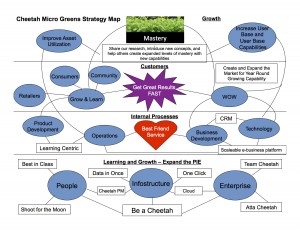High Performing Business – Strategy – Nurture
Michelle LaBrosse, CCPM, PMP, PMI-ACP, RYT

Nurturing the strategies that help achieve our vision through our mission is job one as the Chief Cheetah.
We have a bold vision with our new initiative – Cheetah Micro Greens. This was a product line we created from our research efforts with Alaska Research Garden this summer. Our goal with Alaska Research Garden is to research various ways to cost effectively create a year round food production system in rural Alaska. Over the summer we pursued three different research projects – hugel culture raised beds, geodesic dome green houses, and indoor climatically controlled agriculture. For the indoor climatically controlled agriculture, we tested out if we could efficiently and cost effectively grow micro greens in a grow tent (originally designed for the marijuana industry). Our goal was to create a simple, and inexpensive system easy enough to set up and run by a middle school science class. There is a similar sized system by a company called Urban Cultivator, that requires a plumber and an electrican to install and is over $10,000 US. While the system is beautiful, we felt this was outside the price range and installation complexity for most people – especially in rural Alaska where it is difficult to retain skilled tradesmen for the installation (and possible repair as there are complex electronic controls in the Urban Cultivator system).
We tested installing our efficient grow tent throughout the community in our small rural town in Alaska. We wanted to verify other people could generate good results with this inexpensive approach as well. Buoyed by the success the school, local grocery store, and two small farms had in Alaska with our system, we decided to head south and expand it into the lower 48 through our headline brand “Cheetah Learning.” We call our system Cheetah Micro Greens – since our climatically controlled system does in fact grow the micro greens faster than the conventional ways of growing them outdoors and in green houses. (We do not know how quickly we could grow micro greens in the Urban Cultivator but the grow times they provide for their seeds are about twice as long as what we see in our system for similar seeds).
The vision for “Cheeth Micro Greens“is pretty simple: With the right training and systems, most people can efficiently and cost effectively grow their own food year round. Our mission is to: Create inexpensive, easy to set up, operate and maintain systems that enable people to grow micro greens year round (cheetah fast) and provide training for ways to use, share and/or sell the micro greens in their communities. Strategies are the way we achieve our vision through our mission. Our strategies are defined through the lens of a strategy map process I learned in the Harvard Business School’s Owner President Managed (OPM) program (I graduated HBS OPM 35). The strategy map shows how we integrate the team, with our internal processes, our customers, and our core growth strategy. The three core elements of our strategy are:
- to use research based methodologies with accelerated learning to grow ours and others capabilities to mastery.
- to create inexpensive systems that are easy to use and generate great results, fast.
- to interact with others using our best friend service model.
Back in full blown business development mode here as this initiatve takes off, I find myself nurturing the various elements of these strategies, as we develop the team that is bringing this vision to life through our mission. We now have a team of 14 helping to launch this new product line. I’m using Cheetah Learning’s well proven strategies to build these new capabilities and sharing them with others through the Project Micro Green class.


